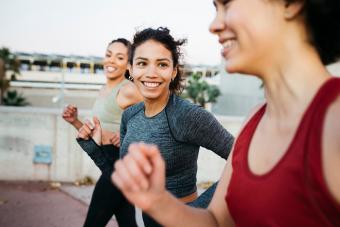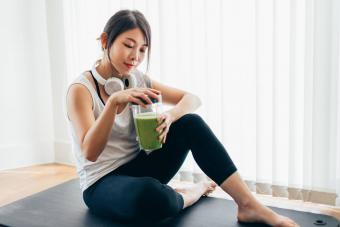
Flexibility exercises help to maintain or improve range of motion for joints. Increasing your flexibility will not only help you move better, but it can also help you avoid injury.
Intentional Flexibility Improvement
Try these exercises to help improve your flexibility. If you have previous injuries, speak with your physician or physical therapist about suitable exercises for your goals.
Shoulder Flexibility Exercise
The dead bug floor slide can be done from the floor, or standing up against a wall if taking it to the ground is too difficult.
- Lying supine, bring your bended legs up to a 90-degree angle.
- Your back should press into the floor, but don't force it. There may be a slight curve in your lower back, which is natural.
- Bring your arms up and above your head, as though mimicking a goal post. Your palms should be up and the back of your hands touching the floor.
- Pressing your arms against the floor, push your arms away from your head, straightening your arms.
- Squeezing the shoulder blades, flex your arms back into their original starting position.
Lower Back Flexibility Exercise
Yoga's cobra pose (Bhujangasana) is a back bend that can improve lower back flexibility; in fact, adding yoga to your workout regimen will help overall flexibility and will do so in a controlled way, leading up to cobra pose slowly. This isn't an exercise you want to simply drop into without first warming up your body and preparing your lower back for the movement.

Upper Back Flexibility Exercise
A hanging stretch involves hanging from a pull up bar or horizontal beam.

- With an overhand grip, allow your arms to go straight and your body to hang.
- Try to focus on releasing your upper back while you hang.
- Don't swing your legs, but instead allow them to hang and pull you downward.
- Stay in the hang for 30 seconds (or as long as you can, up to 30 seconds).
Hip Flexibility Exercise
The butterfly stretch helps stretch the hip flexors and grant you more flexibility in this region over time.

- Sit on the floor with your spine neutral.
- Open your legs and with bent knees, place your feet together at the heels and the balls of your feet.
- Draw your feet closer to your groin area while not slumping over.
- Try to draw your knees close to the ground.
Leg Flexibility Exercise
A classic quad stretch can help you regain (or gain) flexibility in your legs. You can do this exercise while holding onto a chair or wall if your balance won't allow you to do it freestanding.

- Stand tall with a neutral spine.
- Bend the knee of your right leg, drawing your foot behind you.
- Use your right hand to grasp the right foot or ankle.
- Align yourself to where your knees are even. Don't lock your left knee, but instead keep it soft.
- Focus on pushing your pelvis forward, which will intensify the stretch in your quads. Hold the stretch for 30 seconds.
- Return to a standing position on both feet and do the left side.
Improving Overall Flexibility
Stretching and staying active will help improve your flexibility overall. Inactivity is the enemy of flexibility. You will likely notice a decrease in your flexibility as you age, but you can combat this by the same means: stretching often and staying active. There is a genetic component to flexibility, so if it always seems as though you can't achieve flexibility no matter what you try, don't allow this to stop you from stretching and staying active.
Cautions on Static Stretching
Static stretching - that is, stretches that are held in one place without movement - is great for increasing flexibility but can lead to injury if done without first warming up the body. Save your static stretches for the cooldown portion of your workout and instead do dynamic (moving) stretches in your warm up to prepare the body for movement.
Discomfort Without Pain
Any exercise you do in an attempt to improve your flexibility may result in some discomfort, which is fine and expected, but if you feel pain you should stop the move immediately. You don't want your attempts at increasing flexibility to lead to injury.
Timing Is Important
Aim to complete flexibility exercises three times a week for best results - this allows your body valuable recovery time in between flexibility sessions. Try to complete each exercise 3-5 times on each side. For timed flexibility stretches, aim for 30 seconds.
Beneficial Moves
Increased flexibility equals increased movement capabilities and will increase your quality of life. Set workout time aside to focus on flexibility on a regular basis, no matter what age you are now.







